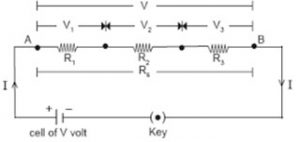Question 1 What is meant by series combination of resistors?
Question 2 You are provided with three resistors R1, R2 and R3 .
Write the formula for the equivalent resistance R when there resistors are connected in series?
Question 3 A resistance of 6 Ω is connected in series with another resistor of 4 Ω. A potential difference of 20 volts is applied across the combination. Calculate the current through the circuit and the potential difference across 6 ohm resistance?
Question 4 Three resistors 4 Ω, 6 Ω and 10 Ω are connected in series. The potential difference across the combination is 5 V. Calculate the potential difference across each resistor?
Question 5 Why series arrangement of resistors is not used in domestic electric circuit?
Resistance of a system of Resistors
Resistors can be connected with one another in 3 ways:
Resistors are connected in series
V= V1 + V2 + V3
V = IR
V = I R1 + I R2 +I R3
V = I Rs
Rs = R1 + R2 + R3
Two or more conductors are said to be connected in series if they are connected one after other such that same current flows through each conductor when potential difference is applied across the combination.
Series arrangement of resistors is not used in domestic electric circuit.
If all electrical appliances are connected in series and if any one them fuses(break),then all other appliances will not work. This is because in series arrangement there is only single path for flow of current.
Total potential difference across combination of resistors is equal to sum of potential differences across the individual resistors.

Leave a Reply